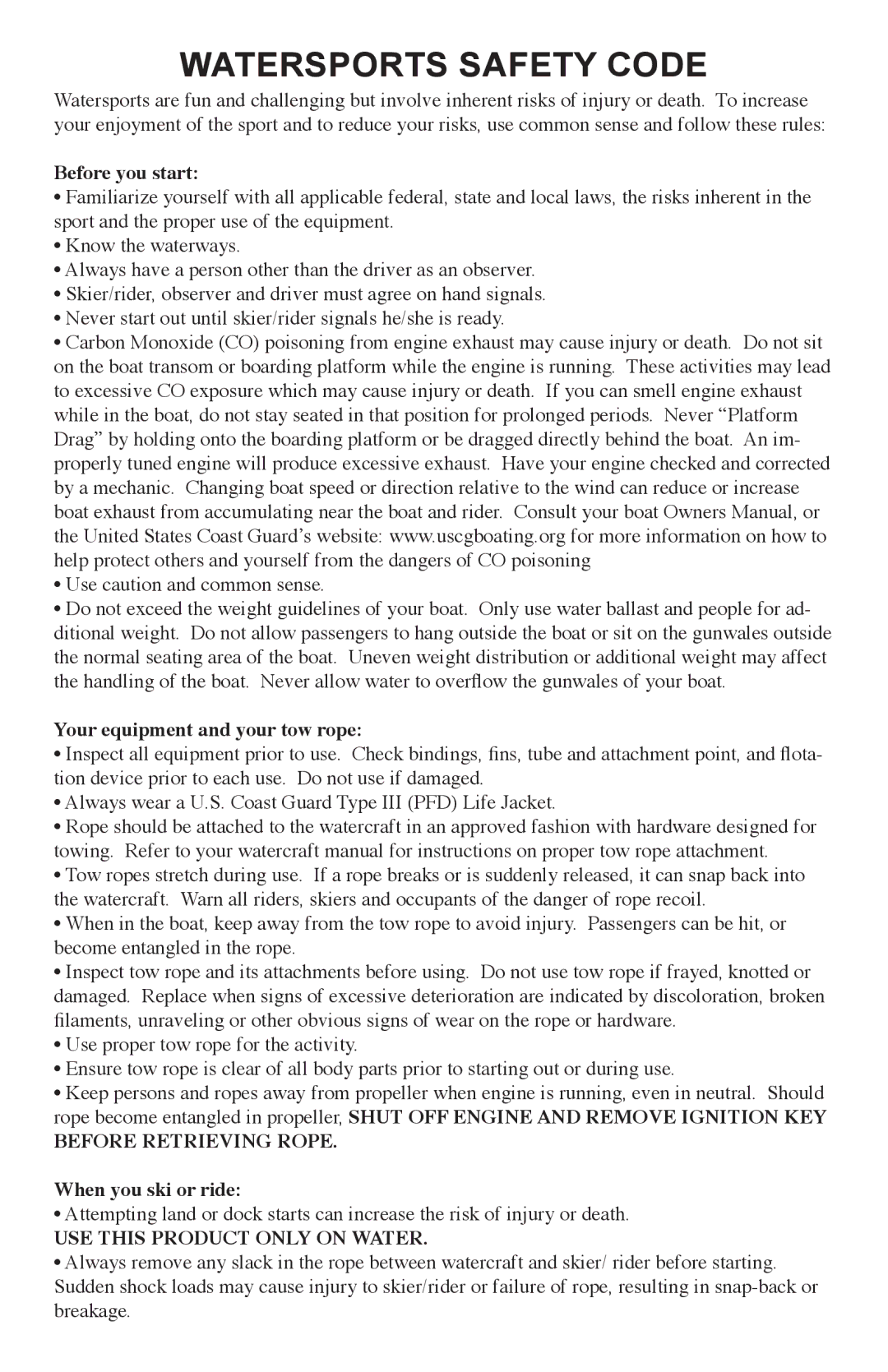WATERSPORTS SAFETY CODE
Watersports are fun and challenging but involve inherent risks of injury or death. To increase your enjoyment of the sport and to reduce your risks, use common sense and follow these rules:
Before you start:
• Familiarize yourself with all applicable federal, state and local laws, the risks inherent in the sport and the proper use of the equipment.
• Know the waterways.
• Always have a person other than the driver as an observer.
• Skier/rider, observer and driver must agree on hand signals.
• Never start out until skier/rider signals he/she is ready.
• Carbon Monoxide (CO) poisoning from engine exhaust may cause injury or death. Do not sit on the boat transom or boarding platform while the engine is running. These activities may lead to excessive CO exposure which may cause injury or death. If you can smell engine exhaust while in the boat, do not stay seated in that position for prolonged periods. Never “Platform Drag” by holding onto the boarding platform or be dragged directly behind the boat. An im- properly tuned engine will produce excessive exhaust. Have your engine checked and corrected by a mechanic. Changing boat speed or direction relative to the wind can reduce or increase boat exhaust from accumulating near the boat and rider. Consult your boat Owners Manual, or the United States Coast Guard’s website: www.uscgboating.org for more information on how to help protect others and yourself from the dangers of CO poisoning
• Use caution and common sense.
• Do not exceed the weight guidelines of your boat. Only use water ballast and people for ad- ditional weight. Do not allow passengers to hang outside the boat or sit on the gunwales outside the normal seating area of the boat. Uneven weight distribution or additional weight may affect the handling of the boat. Never allow water to overflow the gunwales of your boat.
Your equipment and your tow rope:
• Inspect all equipment prior to use. Check bindings, fins, tube and attachment point, and flota- tion device prior to each use. Do not use if damaged.
• Always wear a U.S. Coast Guard Type III (PFD) Life Jacket.
• Rope should be attached to the watercraft in an approved fashion with hardware designed for towing. Refer to your watercraft manual for instructions on proper tow rope attachment.
• Tow ropes stretch during use. If a rope breaks or is suddenly released, it can snap back into the watercraft. Warn all riders, skiers and occupants of the danger of rope recoil.
• When in the boat, keep away from the tow rope to avoid injury. Passengers can be hit, or become entangled in the rope.
• Inspect tow rope and its attachments before using. Do not use tow rope if frayed, knotted or damaged. Replace when signs of excessive deterioration are indicated by discoloration, broken filaments, unraveling or other obvious signs of wear on the rope or hardware.
• Use proper tow rope for the activity.
• Ensure tow rope is clear of all body parts prior to starting out or during use.
• Keep persons and ropes away from propeller when engine is running, even in neutral. Should rope become entangled in propeller, SHUT OFF ENGINE AND REMOVE IGNITION KEY
BEFORE RETRIEVING ROPE.
When you ski or ride:
• Attempting land or dock starts can increase the risk of injury or death.
USE THIS PRODUCT ONLY ON WATER.
• Always remove any slack in the rope between watercraft and skier/ rider before starting. Sudden shock loads may cause injury to skier/rider or failure of rope, resulting in
